A step by step guide on how to grow sweet potatoes & how to start slips. Growing sweet potatoes used to be a closely guarded secret among farmers. A mystical, mysterious process - like how to perfectly apply liquid eyeliner. Not anymore!
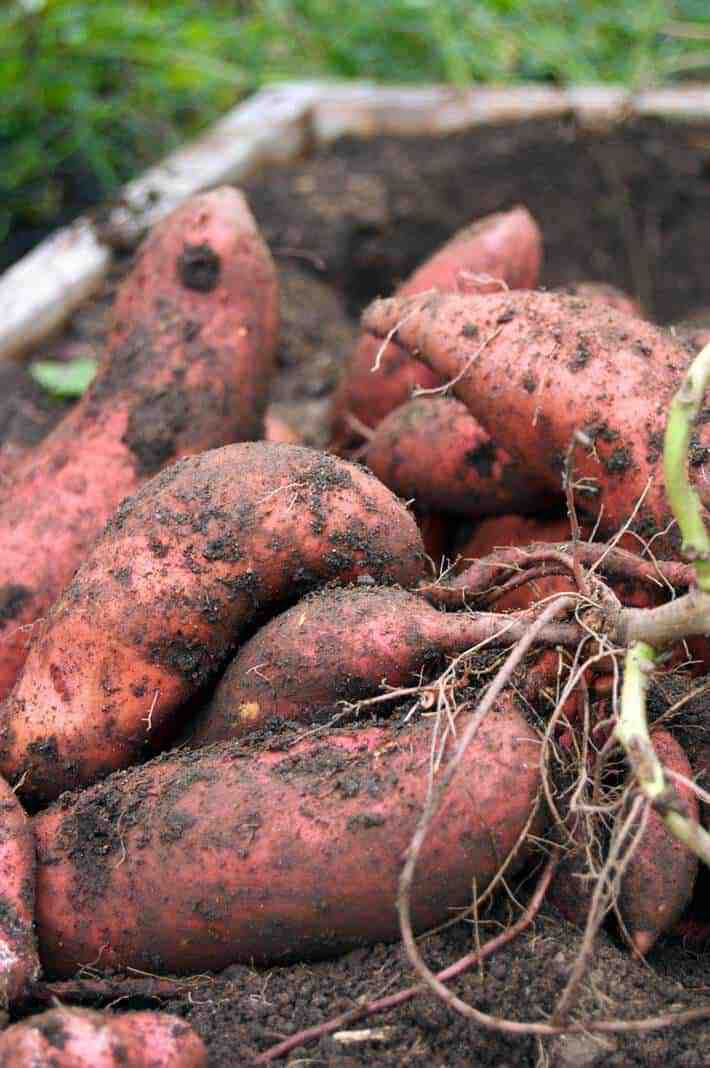
I've successfully taught thousands of you how to grow luffa in a cold climate (zone 6) and sweet potatoes (known as Kūmara where it's hugely popular in New Zealand) are no different.
It can be done and you can get a HUGE harvest even in a short season - you just need to follow the steps.
In 2010, when I first started growing sweet potatoes (Ipomoea batatas), there was almost no information on the Internet about it. At that time, growing sweet potato slips was a closely guarded secret in the farming community.
Not anymore.
Table of Contents
Two ways to grow sweet potato plants
🌱 It starts with growing the slips. 🌱
In order to grow sweet potatoes, you have to first grow sweet potato slips. These are the sprouts that come off of the sweet potato.
Every slip will grow into a sweet potato plant that will produce around 2 pounds of sweet potatoes
1. IN WATER
2. IN SOIL
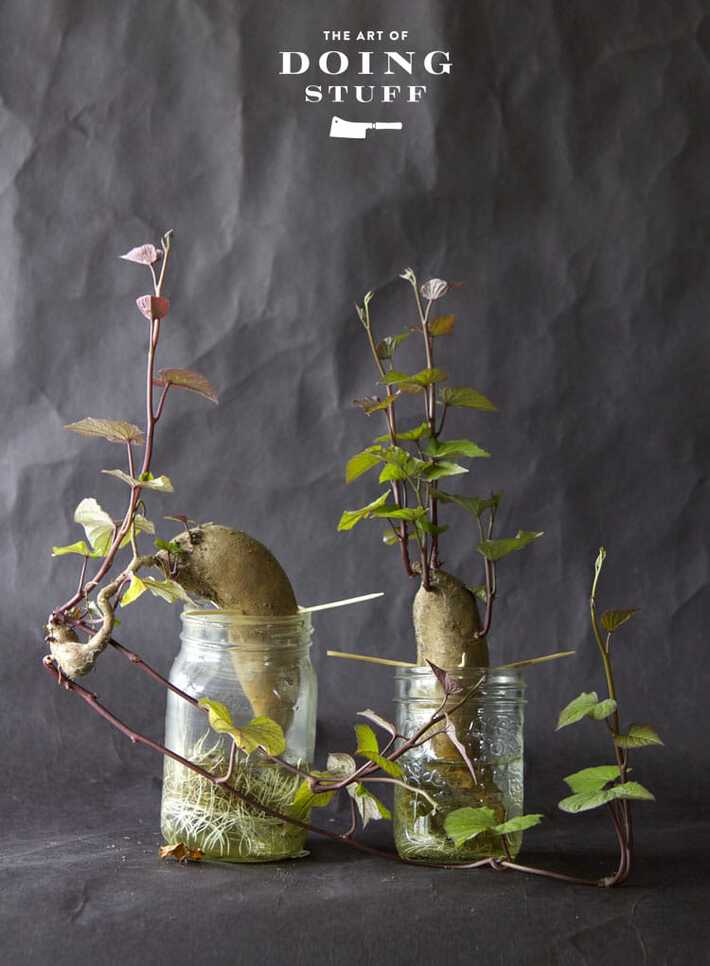
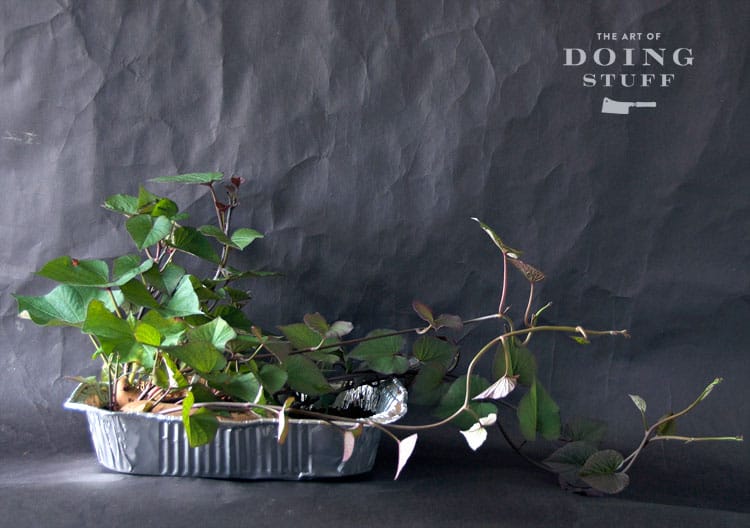
Sweet potatoes sprout after they break dormancy just like the perennial plants in your garden do. These sprouts are called slips and they're what you use to grow sweet potato plants.
You can encourage your sweet potato to break dormancy by putting it in a warm room in either a glass of water or some soil.
Water Method
With this method you're generally safe to start your slips 6 weeks prior to when you want to plant them out.
STEP 1. Place sweet potatoes in a glass jar of water with half the sweet potato under water and the rest not. The part under water will grow roots and the part above water will grow slips.
STEP 2. Put the jar somewhere WARM - over 80℉ is ideal. Now you wait about a month for it to root and sprout.
STEP 3. Once the slips are a few inches long they can be pinched off of the sweet potato and rooted in water or planted in 4" pots.
STEP 4. Slips can be planted outside once the soil temperature is 65ºF (or 18ºC).
Soil Method
The soil method produces slips more quickly. With this method you're generally safe to start your slips 4 weeks prior to when you want to plant them out.
STEP 1. Place whole sweet potato(es) lengthwise in a pan of soil so the soil comes halfway up the side of potato.
STEP 2. Place the pan on a seedling heating mat.
STEP 3. Make sure the soil stays moist and wait for it to produce roots / slips in 2 weeks or less.
STEP 4. Once the slips are a few inches long and you can either put them in a glass of water to root, or plant them directly in soil to root. Either way is fine. Rooting in a glass jar takes up a lot less space than putting each slip in a 4" pot with soil.
STEP 5. Slips can be planted outside once the soil temperature is 65ºF (or 18ºC).
TIP! It's the warmth of the heat pad that speeds up the sprouting process.
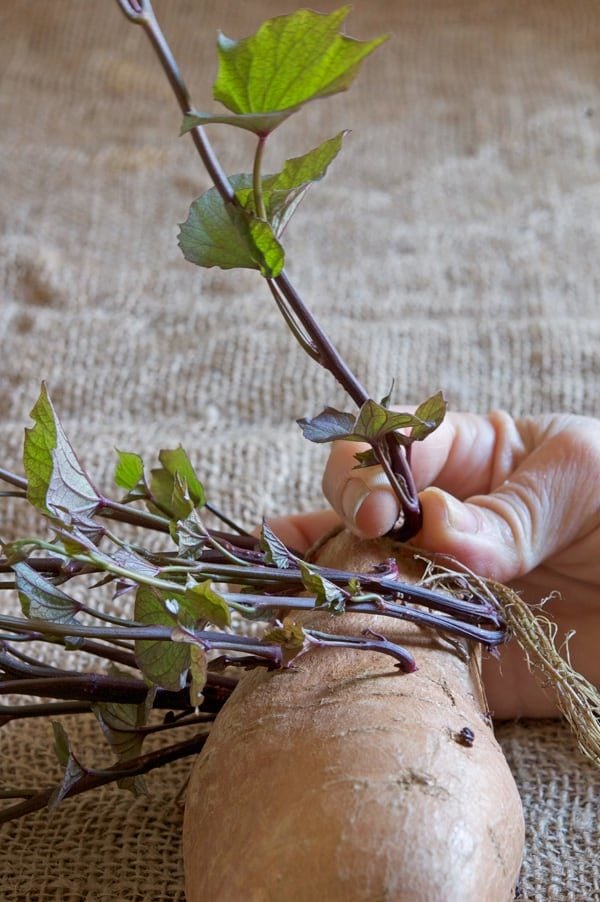
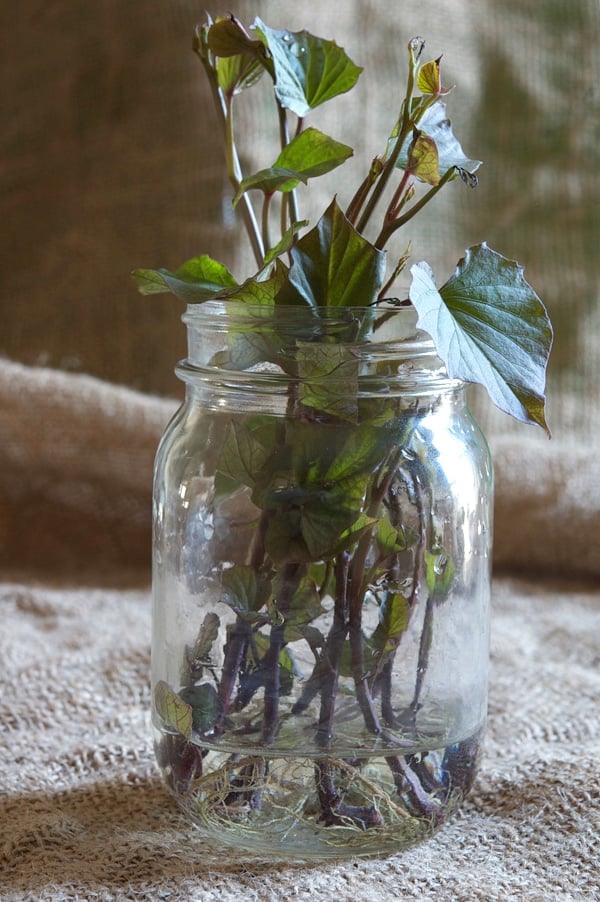
How to plant
Sweet potatoes will be one of the last things you plant in your garden. They must go in later than peppers, tomatoes and other heat loving plants because sweet potatoes need more than just warm weather. They need warm soil as well as warm air.
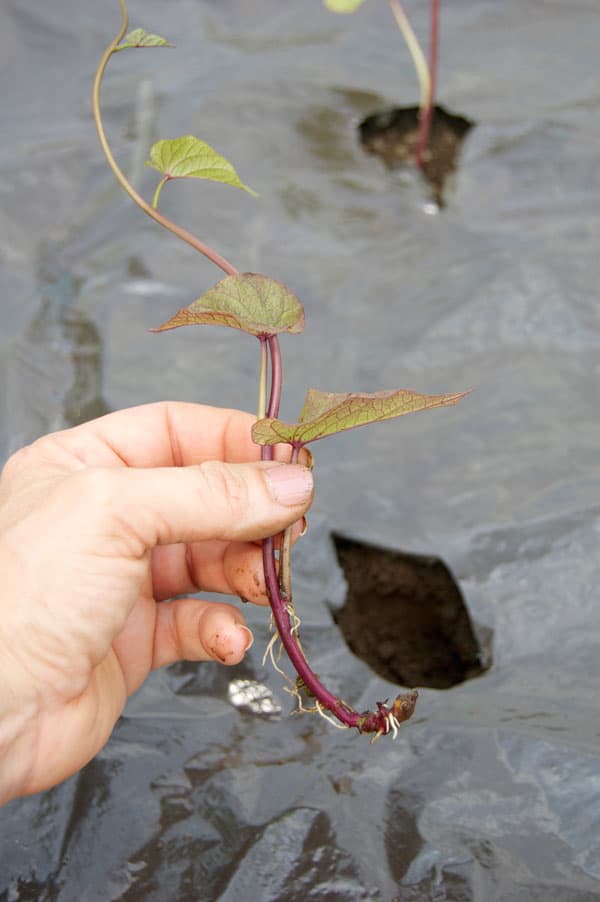
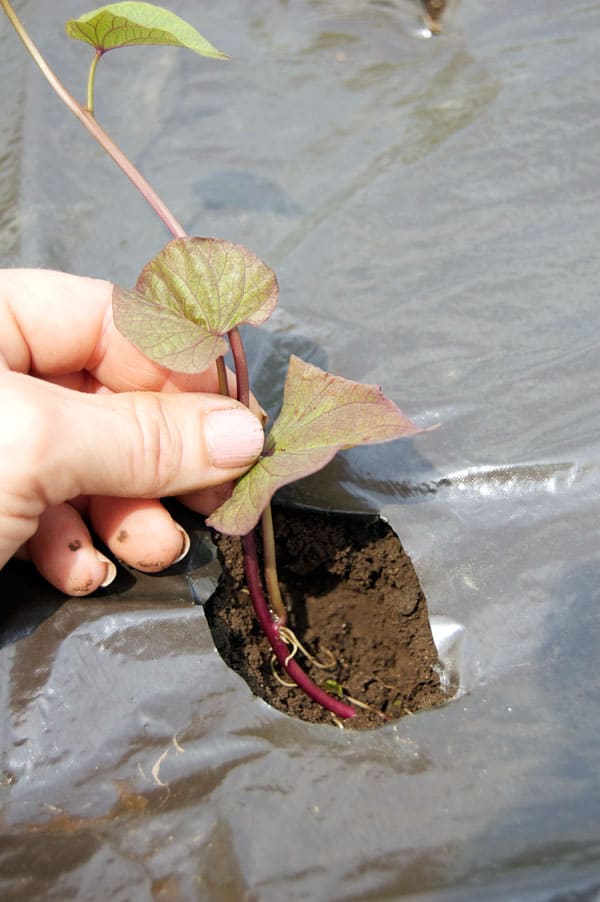
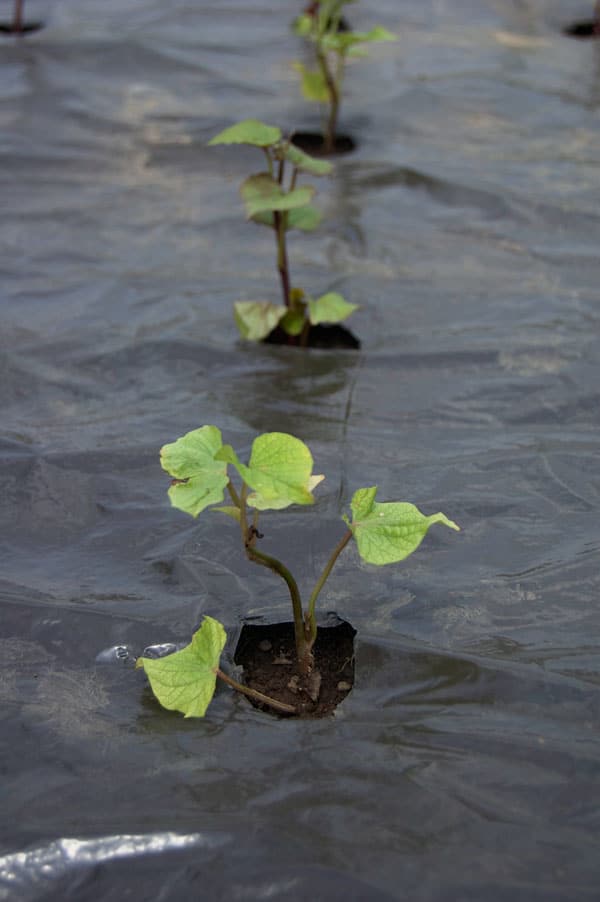
STEP 1. Apply a couple of inches of compost to the top of your soil. You can also use a slow release fertilizer; I use Gaia Green's organic 4-4-4 all purpose fertilizer in my garden.
STEP 2. Lay black thermal mulch (plastic) on the planting area 2 weeks before setting out. Sweet potatoes need full sun so make sure your area has that.
STEP 3. On planting day cut a circle in the plastic and push one slip in. Make sure the slip has contact with soil all around. Repeat for all your slips.
STEP 4. Proper spacing for planting is 1 sweet potato slip per square foot. HOWEVER, I find spacing of 16" between sweet potato plants increases your yield & the size of your sweet potatoes.
STEP 5. Keep the plants well watered throughout the summer. Using the plastic eliminates the need to weed and helps retain moisture.
STEP 6. Harvest before the first frost. Once the weather cools down they won't grow anyway.
* Speed up your soil warming by laying a layer of black thermal plastic in your garden bed. I use biodegradable plastic made of cornstarch that just decomposes on the soil by the end of the season. It will heat the soil up by as much as 10 degrees which means you can plant the slips 1-2 weeks sooner than if you don't use thermal plastic.
.
Growing in beds
Growing in containers
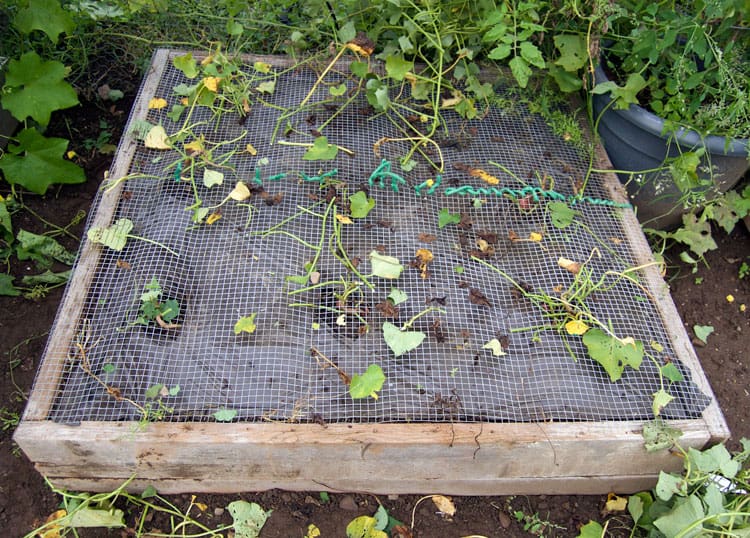
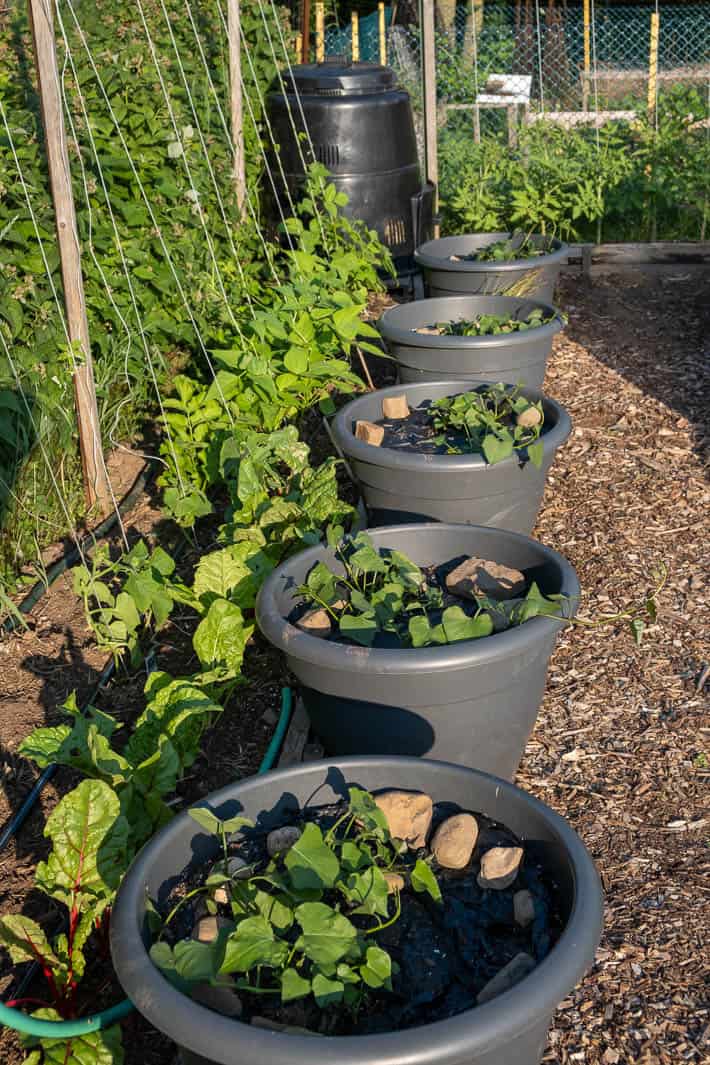
If you grow sweet potatoes in the ground you may find voles & mice get to them before you do. Hardware cloth can help with this. If you can't find it locally, Amazon carries hardware cloth.
- Cover your sweet potato bed with ¼" hardware cloth. Grow your sweet potatoes in a raised bed with wood sides. After laying your plastic down, staple hardware cloth around the edges of your bed.
- Plant the slips you have to punch a hole into the plastic with a pencil and push the slip through the hardware cloth, plastic and into the soil. THIS IS A PAIN. But it eliminates 100% of rodent damage.
I grow all of my sweet potato plants in containers.
- Plant 1-2 sweet potato slips in a 60 litre pot that measures 60 cm across.
- Remember to keep the pots watered as they'll dry out more quickly than a garden bed.
Once your plants are well established you can also harvest and eat the leaves.
Use them in: salads or cook them like you would spinach or chard.
Would you like to save this stuff?
This video shows my sweet potato harvest in 2016 after I tried using the hardware cloth the first time in a raised bed in my 40' x 40' community garden plot. In this video I'm using regular thermal plastic, not the biodegradable plastic.
How & When to Harvest
Near the end of their growing life sweet potato vines will start to yellow and croak. This is a GOOD sign! They're ready to harvest.
- Cut the tangle of vines away, leaving only a few stubs to let you know where the plants are.
- Using a shovel or digging fork, dig em up! Honestly, the most fun crops to grow are the ones that grow underground because you have NO idea what you have until the day you dig them up.
- Be careful when you're digging them and pulling them out. They bruise and break easily.
- Once they're all dug let them sit in the sun for a few hours to dry and begin the curing process.
If the vines get touched by frost and start to turn black the sweet potatoes can rot quickly so dig them up right away!
How to Cure & Store
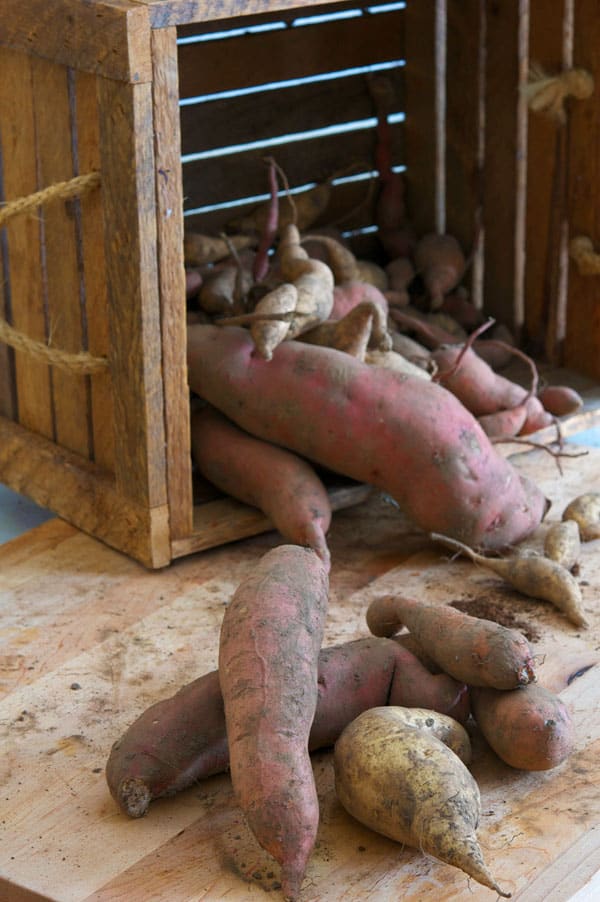
Curing
Sweet potatoes need to be cured for 10 days in an area that is 85ºF with 85% humidity. Getting those conditions at home probably seems difficult but just get as close to those ideal conditions as you can.
Why do you have to cure sweet potatoes? Curing toughens the skin so they keep longer and it develops their distinct sweet flavour. A sweet potato dug straight out of the ground won't taste sweet at all! Try it.
Here's how:
- Put your sweet potatoes in a rubber bin with the lid offset so it isn't completely sealed off. Store this near a heat register, wood stove or sunny spot. This will create conditions as close to perfect as you can get in most houses. DO THIS FOR 10 DAYS.
- After the initial 10 day curing period move your sweet potatoes to an area that is between 55-60ºF for one month. This develops their flavour. After 1 month they will have developed their sweet potato flavour which will get even stronger as time goes by.
Storing
Store sweet potatoes in an area that doesn't get below 50 degrees in a container that breathes like a slatted wood box or a burlap sack.
How many sweet potatoes do you get per plant?
2 lbs or 4 sweet potatoes per sweet potato plant.
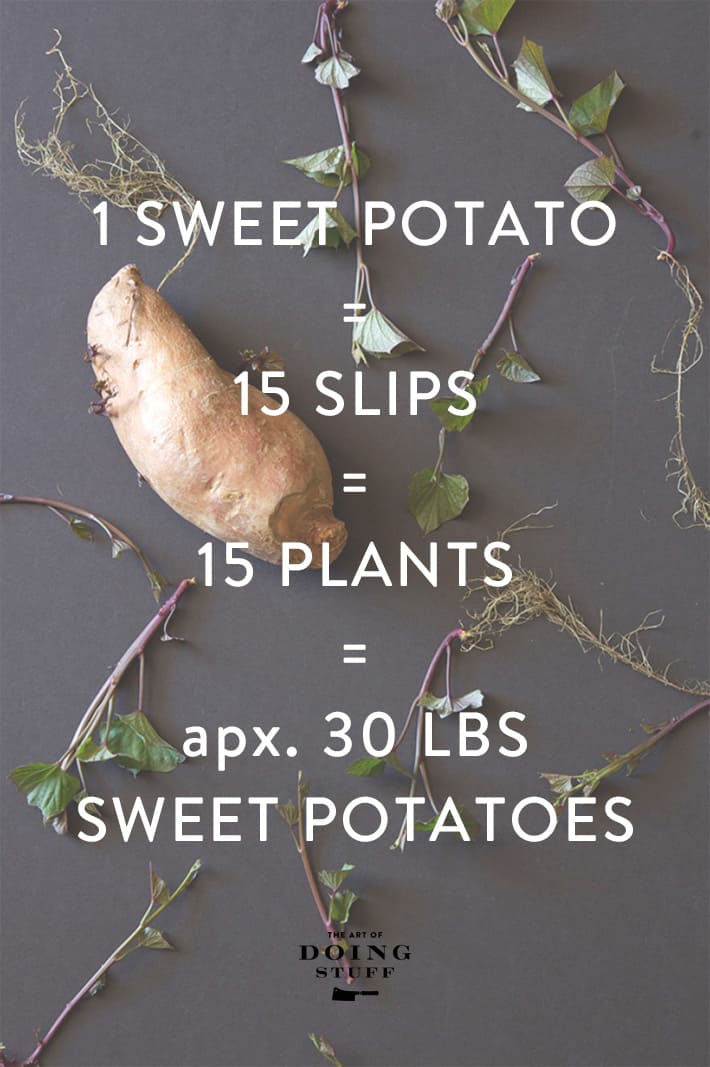
1 sweet potato plant will produce about 4 large sweet potatoes, or 2 lbs of sweet potatoes. Some varieties will produce 6 or more per plant.
The plant usually creates 1 very large sweet potato, along with a few smaller ones.
A single sprouting sweet potato can provide you with at least 15 slips (that's a low estimate). Those 15 slips will create 15 plants, which will give you around 30 lbs or 60 individual sweet potatoes.
Where to buy slips
If you don't want to grow your own you can buy potted sweet potato plants at many garden centres now and you can order live slips online.
Growing from store bought sweet potatoes
To grow your own slips all you need is a sweet potato that hasn't been treated to stop sprouting which you can get at the grocery store.
How do you know if it's been treated? You don't. You go to the store, buy your sweet potato and hope for the best. Organic is your best bet for an untreated sweet potato, but both organic and "regular" store bought sweet potatoes have produced slips for me.
Tips on picking a sweet potato from the store to grow
- Check for cold damage. If the sweet potato has been exposed to below 55 degree temperatures it will probably rot rather than sprout. Cold damage presents with dark marks and lesions.
- Bigger isn't necessarily better. Small sweet potatoes, in my experience, have produced more slips than larger ones.
- Ask if they were grown locally. Locally grown means it will grow well in your region.
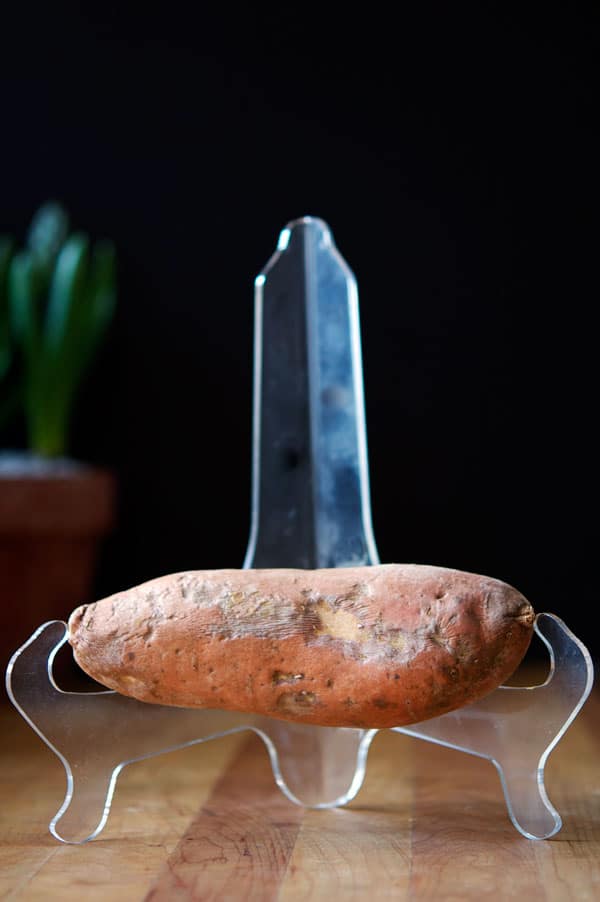
Sweet Potato with cold damage
Once you've established your very OWN crop of sweet potatoes you can use those for producing slips year after year.
Are ornamental sweet potatoes edible?
You may have noticed that your ornamental sweet potatoes also produce tubers. These tubers are edible but not delicious.
The good news is you can propagate ornamental sweet potato vine the same way as regular sweet potatoes! Just dig up the decorative sweet potato tuber in the fall, store it in a cool room, and then encourage it to grow slips in the spring. These slips can be planted directly outside or rooted and potted up for later planting.
Varieties of Sweet Potatoes
The most popular sweet potato variety by far is Beauregard and it'll be the easiest for you to find. But there are a lot more varieties than that.
- Beauregard* (best all around sweet potato variety)
- Georgia Jet (short season variety)
- Jewel (longer season but still doable in colder climates)
- Garnet (a purple variety with purple skin and flesh)
- Stokes (bright purple variety that retains its colour after cooking)
- Covington (a standard variety that grows well in cooler cliimates)
*this is the sweet potato I most often grow.
Note: I have successfully grown all of the above (with the exception of "Stokes") in my Canadian garden. I just haven't tried Stokes, but I'm sure it would be fine.
Sweet Potato VS Regular Potato
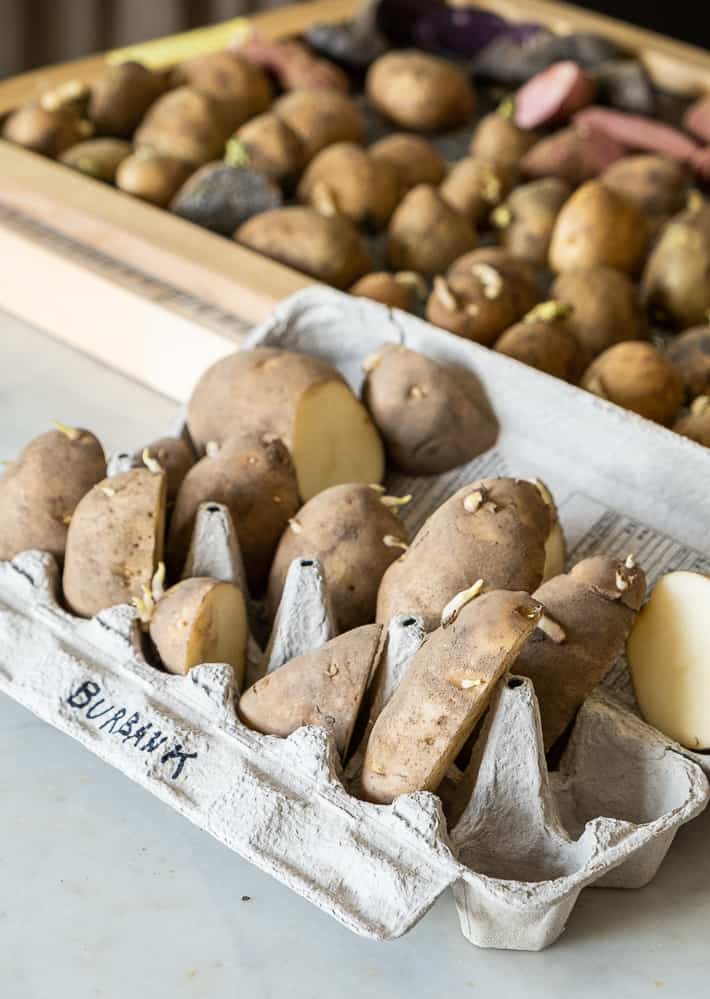
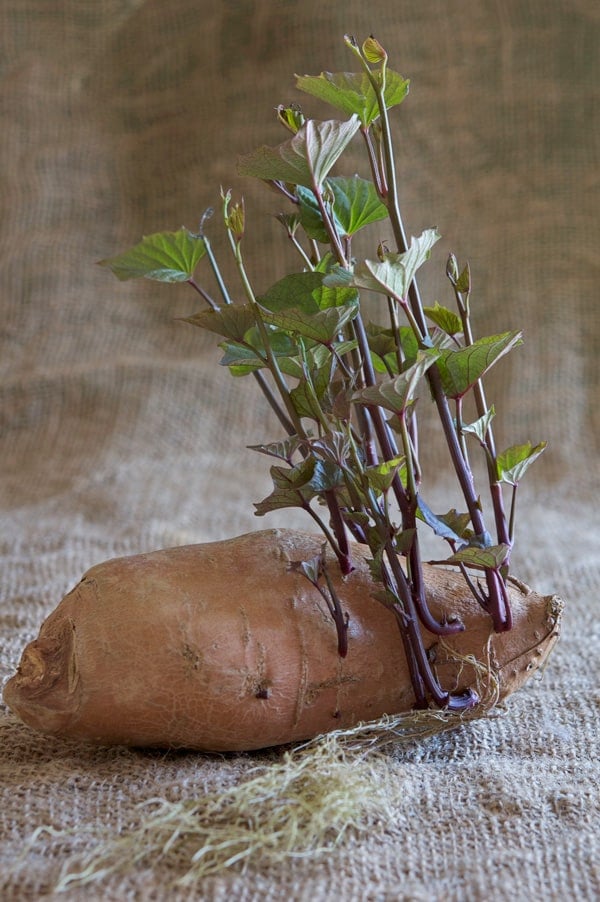
To clear up any confusion, sweet potatoes don't grow like regular potatoes. A regular potato is a tuber, a sweet potato is a root.
Regular potatoes are grown by planting whole "seed" potatoes into the ground. (here's my guide on how to grow regular potatoes)
Sweet potatoes are grown by planting only the sprouts aka slips that grow from the sweet potato.

The Start to Finish Guide to Growing Sweet Potatoes.
How to successfully grow sweet potatoes whether your garden is big or small.
Materials
- Glass of water
- Foil pan with soil
- A sweet potato
Tools
- Heat mat
Instructions
- Start sweet potato slips 6 weeks prior to planting out.
- Rest a whole, undamaged sweet potato in soil and set on a heating mat. Slips will start to grow in around 2 weeks. When around 5", break slips off of sweet potato and plant out or root in water.
- Rooted AND unrooted slips can be planted directly in the soil.
- Speed up how quickly you can plant your slips outside by laying down thermal plastic
- To prevent vole/mole/mouse damage either grow sweet potatoes in very large pots or grow in a raised bed with wood sides and ¼" hardware cloth across the top.
- Dig up sweet potatoes when the weather cools in fall.
- Cure sweet potatoes at 85F and 85% humidity for 10 days.
- Cure another month at 55-60F allowing potatoes to develop sugars.
- Store long term in vented crates or burlap bags at no colder than 50F
Sweet potatoes can be harvested 4 to 5 months after planting.
You get around 4 sweet potatoes per plant. Usually one very large one and a few smaller but still substantial ones. Some varieties under the best conditions will produce even more.
Any potting soil will work well. It has the nutrients you need. If you are reusing potting soil you'll need to amend by adding fertilizer. Adding a 4-4-4 fertilizer or a few inches of compost to the top of the depleted potting soil will revive the soil. I also use native garden soil in my sweet potato containers.
Yes, that's exactly how you grow them but you don't plant the entire sweet potato. You let the sweet potato sprout in a warm place, pull the sprouts off when they're a few inches long and then root or plant those in soil.
May or June are the best months to plant sweet potatoes outside when the soil at planting depth has warmed up to 65ºF (or 18ºC).
Yes! Sweet potatoes do really well in beds, buckets or pots. Buckets and pots are especially good for growing sweet potatoes because they keep the soil warm and prevent moles and mice from eating the growing tubers.
Once you have a whack of sweet potatoes that you've grown yourself, if stored in good conditions, they'll last you into April or even May.
You can turn them into my personal favourite guaranteed crispy Sweet Potato fries with a Sriracha/mayo dip, Sweet Potato soup or sweet potato casserole.
Now go forth and grow.
→Follow me on Instagram where I often make a fool of myself←




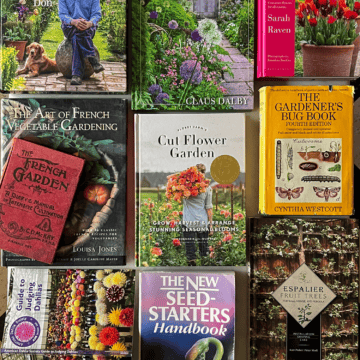
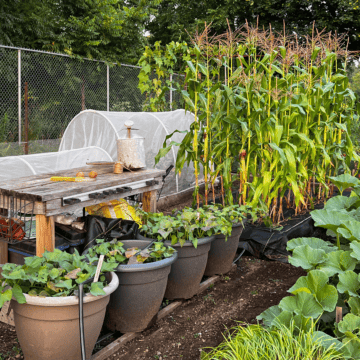
Hugh Holland
Hi,
After you have the slips, what do you do with them after you break them off? I guess the choices would be to plant in the garden, put them in water until they develope more roots, or pot them until they have roots.
The weather isn't good enough where I live to plant them yet.
Thanks-Hugh
Karen
Yup, those are all your options, lol. And all of them work well. I honestly haven't noticed any difference in production regardless of how I start the slips. I usually stick them in a mason jar with water to root until it's warm enough out to plant them out at the beginning of June. It takes the least amount of room and is faster than potting them all up. If the plant is still producing slips at he beginning of June (and it always is), I take any of the last slips off of the sweet potato and plant them directly in the garden. ~ karen!
Hugh Holland
I had a few very long slips that I broke off and put in water. They are producing roots but keep wilting badly every time i put them in the sun and it's only low 70's here. When i put them in the dark them perk back up
Andrew
I started your method about 10 days ago. I haven’t noticed any change yet when I just checked the sweet potatoes they seemed soft on the bottom, almost as if the potatoes were rotting? Is my soil too moist?
Karen
It could be. It could also be that the potatoes you're using have been cold damaged. It can take longer than 10 days for them to start to sprout though so I wouldn't give up on them yet. The soil (especially in the beginning) just barely needs to be wet. ~ karen!
Sara
A couple weeks ago I started my sweet potatoes in jars with water. Just read this article and wish I had tried the soil method! Maybe next time. My question is - a few of the jars have started growing some green stuff on the bottom and the water has a green tint. The roots are a little green but the sweet potato above seems to be growing a couple slips. Perhaps the green stuff is algae?? Should I change the water? Leave it? Or just throw away those potatoes? The other jars water seems to have remained pretty clear.
Karen
Hmm. I have no idea what that is, lol. Sounds like it is just algae. I'd rinse everything under water (the potato roots, the jar) refill it and forge ahead. There's no reason to throw them out. :) ~ karen!
Mia
Do you know anything about how many seasons you can grow from the initial slip you planted? I heard that sweet potatoes these days originated in universities and that you can only grow them for 2 or 3 years before you need to get a new slip from the universities due to the potato loosing quality and flavor.
Kelli Silvestro
Glass jar/ water method I have always used because of limited space but I'm anxious to try the pan method. It sounds like you're laying them down lengthwise?
Hugh Holland
Yes, lay them down lengthwise
Hugh
Works great, thanks. The slips started in 2 weeks and are very healthy. I will never use water again
Karen
Great! ~ karen
Karen
HI Karen! I'm a Karen too! Question - I am trying this method for the first time. Got an aluminum roasting pan and put gardener's gold (our local compost) and seed starter mixture in it and placed the organic sweet potato right smack dab in the middle - it looks like a submarine when it's docked! Got the seedling mat under it but am afraid to leave it on all the time - is that safe to do? Also, it's not in direct sun but gets indirect light. Finally - when I water it, should I moisten the whole pan of dirt or just the dirt around the potato? Around the potato is what I have been doing since I planted it three days ago. And I do have a second roasting pan under the first because I poked holes in the first for drainage and wanted to catch any drips. Thanks in advance for your advice!
Chrissy
Hi Karen, it's a Cold Winter day and I'm thinking Spring to stay warm. 😆 My best luck with growing a Sweet Potato Vine - when the potato shows a white sprout, cut a slice of potato including the sprout, lay it sprout down on top of planting soil and watch it grow. I put 2 slices in this hanging planter outdoors, in the sun. The prettiest Vine ever.
Wendy Spatcher
HI Karen, I'm in zone 6b and one of my sweet potatoes from last crop is sprouting nicely, but a little early in morning d January! I plan in setting it in soil at end of February. Do you think it will matter if some sprouts are a couple of inches long already?
Karen
Hi Wendy, that'll be fine. When the sprouts get to be around 5" long you can snap the off and plant them in individual pots if you like. :) ~ karen!
Laurel D
Does anyone know if I can just plant cut pieces directly in the ground
Karen
Hi Laurel D. That's how you would grow a regular potato, not a sweet potato. Sweet potatoes need to grow from slips that you prestart. ~ karen!
Lilly
Hiya Karen, I've started 3 sweet potatos hurried halfway up the side in good potting soil/compost mix, in an aluminum pan holes poke in bottom in a tray and on a heat mat. After 2 weeks they are rooting under the soil yet nothing on top. I do water from the bottom by filling the tray with water. I live in Washington state across the Columbia from Portland, today is April 30th, do I keep waiting?
Karen
Yup. Keep waiting. :) You can also try sticking in another sweet potato in case those ones aren't viable, but it's quite difficult to tell. ~karen!
Jo Cedergreen
Sweet potatoes caught my attention this year, and even though I'm in zone 6b, I thought I'd give them a try. So, last month, I dutifully gave a couple of them little toothpick arms and set them in my east-facing kitchen window. Nice and bright. I never considered the icy, 27-degree F temperature on the other side of the glass would have any impact. Only roots, so far. Then, tonight, Karen, I stumbled upon your initial articles from 2015 and began to suspect the window was not the best location. Better yet, I read this latest update about using a warming pad. Ingenious! I can't wait to try this.
Karen
Good luck JO! I'm in 6b too. Make sure you read all my sweet potato posts for all the tricks about warming the soil and how to cure them after you dig them up. And yes, get a heating pad! Mine are growing like crazy right now. ~ karen!
Nana999
.THANK YOU THANK YOU THANK YOU! I've been trying to grow sweet potato slips in jars with toothpicks for 2 months with no results. Now I'm going for the potting soil and heat mat.
Karen
Keep in mind it *could* be the sweet potato. If it got touched by cold then it won't sprout no matter what you try to do to it. Most grocery store sweet potatoes sprout just fine, so buy a few that look firm with no scars or discolouration and try both methods with them. :) ~ karen!
Tina L.
Hi. There was no reply to Emma's question of 4/17 as to putting the tray in light or dark. Which is best? Thanks.
Karen
Hi Tina L. It doesn't really matter. I've had slips sprout while in the dark (in a cupboard) or while in the light. I keep mine in my basement with natural light from a single window until they start to sprout and then I put LED grow lights on them for 13 or so hours a day. ~ karen!
Chrissy
Hi Karen, thank you for the quick reply. It is loaded with roots but no sprouts anywhere. It is on the Hot Water Heater in the sun. It looks pretty healthy. Guess I'll wait a couple more weeks to see what happens. Do you, or anyone else have any experience with Sugar Beets ? White Sugar Beets ?
Chrissy
HELP, my sweet potato has all roots and NO slips, or sprouts, or leaves. Should I plant the whole potato in dirt ?
Karen
That's OK Chrissy. Just give it time. :) There's no predicting sweet potatoes. But if there are roots there should eventually be slips. Make sure it's in a warm spot (they like heat). But yes, occasionally a sweet potato just up and rots. That usually doesn't happen if it has rooted though. ~ karen!
Michael
No one seems to mention the temperature of the heat pad? Mine are adjustable. Normally set for 80 to 85 degrees to sprout a variety of garden seeds i.e. tomatoes, peppers. So what is the recommended temperature for sweet potatoes?
Karen
It doesn't matter Michael. As long as it's warm. Most seed starting mats generally warm to 10 - 20 degrees (F) warmer than the ambient temperature. So yes around 80 - 85 would work well on your matt. ~ karen!
Nana999
Also, if you can find heating pads that don't have utomatic shutoff, they are cheaper than heat mats. Sunbeam makes one.
Linda
I don't know where I went wrong, this is my first time growing anything I used the water and toothpick method like I did in elementary school, after about 5 days the potato turned to mush, what happened?
Emma Followes
This might be a dumb question but should the sweet potato tray on the heating pad be in the light or in the dark until the slips grow?
Jen Topp
So, when I'm ready to grow them for real in the garden, do I cut the potato into pieces so that each one is one slip? I am new at this kind of potato planting.
Thanks!
Karen
Hi Jen. All the information you need for anything sweet potato related are in the links I included at the end of the post. :) ~ karen!
Jen
DOH! Thank you for not including "you idiot" in your response!